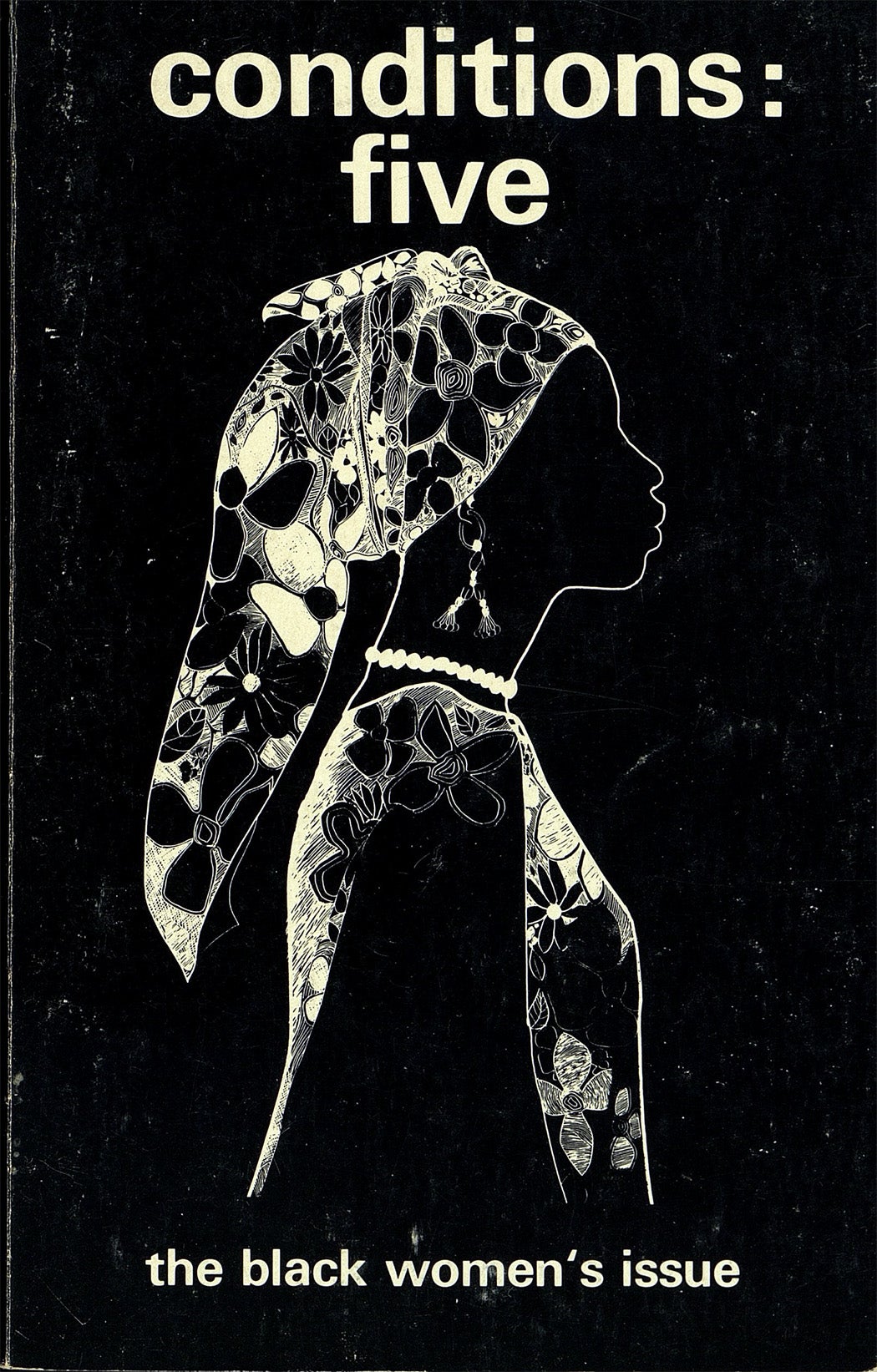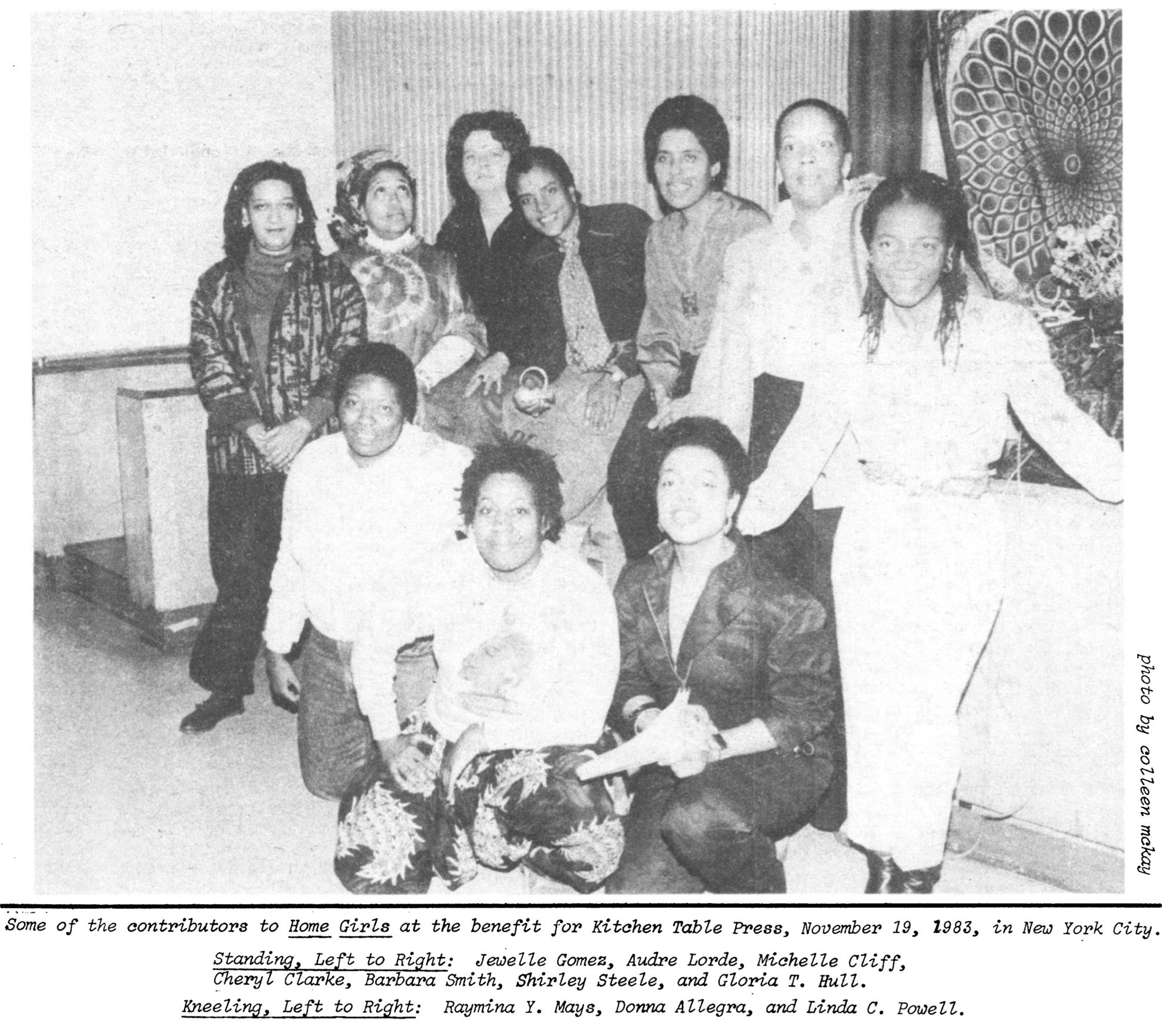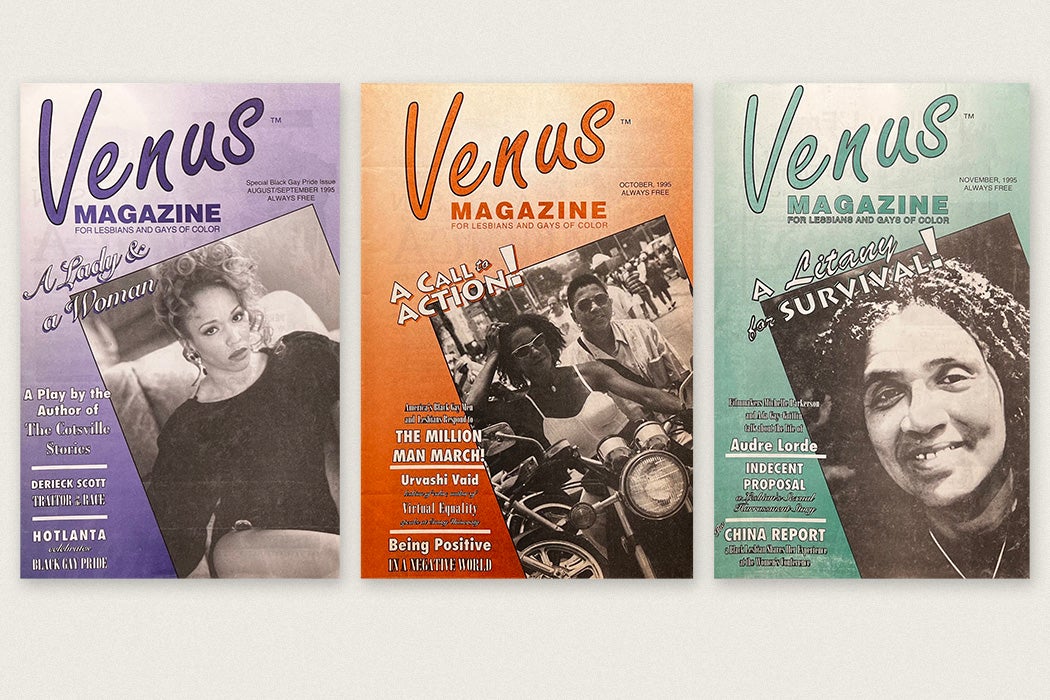In January 1995, Atlanta-based Venus magazine debuted. Charlene Cothran brought it to life three years following the death of Venus Landin—beloved Atlanta Black lesbian activist and community organizer. Venus represented Cothran’s concerted effort to honor Landin’s memory and build on her legacy of raising consciousness in the Black LGBTQ+ community. Venus was created, Cothran wrote in the magazine’s inaugural issue, to center and “reflect the everyday lives of African American lesbians and gay men!”
Intended as a safe space for Black queer people, Venus foregrounded educational resources for HIV and Aids prevention and care, facilitated community between the out and closeted, spotlighted intracommunal dynamics and divergent politics often mired by homophobia, and wrestled with what some saw as inherent tension between Black queerness and Christianity (and religion more broadly). The magazine’s far-reaching vision allowed for diversity in its content. It featured Black queer cultural workers, writers, and theater makers, including the work of multi-hyphenate creators Shay Youngblood (Talking Bones, for example) and Shirlene Holmes (The Cotsville Stories), whose narratives centered on the Black South. As the magazine grew, it also ran interviews with filmmakers Cheryl Dunye (The Watermelon Woman) and Patrik-Ian Polk (Noah’s Arc) and authors Jewelle Gomez (The Gilda Stories) and James E. Hardy (B Boy Blues), among others.
Weekly Newsletter
Critically, Cothran positioned Venus as an anomaly. She argued that a publication with its scope and focus was all but nonexistent within the larger print media landscape. Certainly, such an assertion is debatable; the 1980s and early 90s saw an influx of Black queer print media. Indeed, an August 1991 issue of BLK—one of the first magazines centered on Black queer people—compiled a list of twenty-one extant Black LGBTQ+ periodicals with a variety of frameworks and political identifications. Many of these were explicitly feminist (and otherwise political) or literary, while others focused on Black queer “lifestyle” but still engaged politically charged topics. Regardless of approach, most of these periodicals and their umbrella organizations were based in Los Angeles, New York, Chicago, and Washington D.C. Only one – Associates Newsletter – was located in the South, and its inclusion in the BLK compilation was conspicuous. Despite Cothran’s questionable claim that Venus was unparalleled, it does raise the question: How exactly did the South and queer Black southern voices figure in the larger Black queer print media network and publishing landscape?
Venus offers a lens through which to answer such queries. Indeed, as a southern Black cultural geographic artifact, Venus disrupts what scholar Jaime Harker identifies as dominant discourses of gay magazines and print media, “out liberated gays in urban areas in the North and West and oppressed, closeted queers in the homophobic South.”
A Brief History of Black Queer Publication and Print Media
The mid-1970s and 80s was a period brimming with Black queer feminist literary and media production. Alternative publishing outlets were crucial in response to the exclusion of Black queer perspectives from Black and white mainstream publishing platforms. This pattern extended to Black and white woman-centered publications.
A notable, yet complicated, exception to this marginalization within mainstream Black print media was Essence magazine under the editorial direction of Cheryll Greene. (Cothran described Venus as “sort of along the lines of Essence” in an advertisement in Sojourner magazine.) Greene’s tenure marked a period of diversification of the magazine’s content from a strictly Black beauty and lifestyle periodical to one partly grounded in Black feminist criticism through collaboration and interviews with prominent Black queer and lesbian feminists like Alexis De Veaux, June Jordan, and Donna Allegra. In “Buying (Black) Power: The Story of Essence Magazine,” Black feminist scholar Alexis Pauline Gumbs traces the magazine’s nuances, mining how Black cultural nationalism, capitalism, and patriarchy converged to create a contradictory dynamic. “On the one hand, Essence created space,” she writes, “however contested—for Black feminist writers like Nikki Giovanni and June Jordan, to challenge the prevailing notions of home, family, and labor; and on the other hand, the magazine itself reinforced them.”

Yet outside of the mainstream, Black lesbian and queer writers found publishing opportunities through platforms and networks that both overlapped and diverged. On the one hand, there were lesbian feminist, white-led editorial collective projects and publishers like Conditions Magazine, off our backs, Heresies, and Firebrand Books that ran special issues on (and were guest edited by) Black and Third World women or published now canonical Black queer literature like Cheryl Clarke’s Living as a Lesbian (1986), the U.S. edition of Dionne Brand’s Sans Souci (1989), Jewelle Gomez’s The Gilda Stories (1991), and the expanded edition of Pat Parker’s Movement in Black (1999).
In “‘Fighting to maintain and create our own Black women’s culture’: Conditions Magazine, 1977-1990,” Julie Enszer examines Conditions’ 1981 pivot to an editorial team that was primarily women of color. This came two years after the publication of the groundbreaking Conditions 5: the black women’s issue, which Enszer argues disrupted the conflation between lesbian feminism and white womanhood and positioned the magazine as significant in the history of African American print culture.
“We felt that for many Black lesbian/feminist writers, Conditions represented a rare chance for them to share their work in public,” wrote guest editors Barbara Smith and Lorraine Bethel in the issue’s introduction. Naming the issue’s limitations and contours, they wrote, “It seemed crucial to us that, given the racial/sexual politics of publishing, if we had to choose between giving space to a lesbian/feminist expression of the Black female experience and a less overtly radical treatment of this experience that would have a good chance of publication elsewhere, we should place a premium on providing a voice for the less publishable work.”
Enszer clarifies, however, that many lesbian feminist publications struggled to integrate the voices of women of color, despite Conditions’ commitment to antiracist and coalitional values. As Smith and Bethel proved, doing so was more than possible, as they asserted in their introduction that the existence of the issue itself dispelled the notion feminist publishers had used to justify the exclusion or tokenization of Black writers—that there simply were no Black lesbian or feminist writers to choose from.
Donna Allegra, the Black lesbian feminist poet, dancer, and activist, provides further perspective on the exclusion and tokenization of Black women in her contribution to Heresies’ 1982 “Racism is the Issue” issue. “Black is hip,” she writes, reflecting on her own experiences and their broader implications. “More accurately, now white women are so supremely sensitive to being accused of racism and try to avoid the word like the plague… I resent feeling like they want us around for the power of our image: picture a handsome black woman on the cover of many a magazine that ever so rarely deals with a Black viewpoint.”

In response, Allegra emphasized the importance of the emerging women of color presses and Black queer and feminist writing outlets, foreshadowing what would come to fill the pages of the BLK compilation. The Albany-based Kitchen Table: Women of Color Press, partly catalyzed by Audre Lorde’s 1980 assertion, “we really need to do something about publishing,” offers but one example. This call to action reverberated throughout the following decade: Gap Tooth Girlfriends: An Anthology was born out of the Brooklyn-based writing group of the same name hosted by Alexis De Veaux’s monthly Flamboyant Ladies salon. The quarterly BLACK/OUT, first published in the summer of 1986, was also influential, as it was the magazine associated with the D.C.-based National Coalition of Black Lesbians and Gays. Renowned writer Joseph Beam was at its helm.
On the West Coast, the late 80s saw the birth of Aché, a Black lesbian monthly magazine that ran from 1989 to 1995. It provided a space to process issues affecting the Black lesbian community and gained an international readership even while it was affectionately dubbed the “Bay Area’s journal for Black lesbians.”
As Aché closed its doors, Venus’ opened.
Venus’ South
LaToya Eaves—Black geographer and scholar of the Black queer south—outlines the problem of oversimplified regional discourses in Southern studies and “sociocultural mythology” in her essay, “Outside Forces: Black Southern Sexuality.” This mythology positions whiteness as the default subject and homogenizes the South as “culturally backward” and a “site of abjection.” These oversimplifications, Eaves writes, “insinuate a strict regionalism that does not acknowledge the opportunities, experience, and realities of the entire U.S. South.” More than offering strict definitional parameters around what the Black queer south is against these “monolithic discourses,” Eaves’ focus on Black lesbian and queer women across the south puts forth “narratives in which agency, freedom, and possibility exist.”
The story of Venus embodies one such possibility.
In naming Venus’ importance as a platform for the Black queer south, it is crucial to interrogate what defined it as southern, particularly because it was not explicit in Cothran’s framing. Indeed, the work of Dr. Shirlene Holmes, whose short stories were serialized in the earlier issues of the magazine, better answers this question.

“Mary and Lou” focuses on the experience of a young Black lesbian couple living in the fictional Cotsville. The time that Mary, described by the narrator as part “woman to her heart,” and Lou, part woman “with mannish ways,” spend in Cotsville is mired by rampant, religion-fueled homophobia. The “get to know us” barbecue the couple holds upon their arrival goes awry:
“Clevertta sniffed all the food before she ate it just to make sure it was sanitary. BettyLou wouldn’t even use the restroom; she walked all the way home and had to pee so bad when she got there, she could almost taste it.”
The communal isolation Mary and Lou experience is only fractured by the unsuspecting Missionary Porter—an older, self-identified sanctified, “water baptized,” and “holy ghost-filled” woman, who defends the couple and begins to frequent their home, bringing along fresh baked cornbread and a still warm sweet potato pie.
Though Missionary Porter’s visits confuse the pair, they welcome her, until one day the strange warmth of their non-conversational gatherings is disrupted by Missionary’s invocation of religion. “Why did this old woman have to destroy this evening with a sermon, a testimony, a reprimand,” laments Lou.
In a queer turn of events, Missionary shares how she too had found her way to Cotsville years prior with her lover, an evangelist who, from the age eleven, had decided she’d never be with a man. Missionary’s recollection of their love is tied up in a shared belief in God. “’I used to make her ‘tayta pie and she read me the Bible,’” Missionary says. “’I ain’t never heard of nothing like it. Seem like those folks in the Bible just got up and walked when she read to me.’”
On one level, Holmes intervenes in the discourse about the incoherence of queerness, Christianity, and southern identity. She does not forego the emphatic religiosity of the South, as is typical in the socio-cultural imagination, to make their queerness possible. Instead, it exists within and through it, in a vein that harkens the writing of the Black southern lesbian feminist writer and archivist Ann Allen Shockley, for example. And, the convergence of queerness and religion is not romanticized; it does not resolve the atmospheric violence of the town and Mary and Lou’s experience therein. Indeed, Missionary’s public defense of them was never through the prism of shared identification with the women, though it was suspected, and the promise of secrecy at the gathering’s end further muddies the waters.
Yet their affiliation insists on their presence.
The south of this story is envisioned in a somewhat stereotypical way: through its lethargy, “the trees and grass and lazy dogs,” the intimate knowing in community. However, Holmes’ story reflects what scholars of the Black South have insisted on—thinking the south as a place of multiplicity, irreducible to an overstated “set of historical moments and iconography,” as Eaves writes. The queer southern messiness of the story reflects the kinds of negotiations and contradictions that hover over Black queer southern life.
Holmes continues to build on this narrative with more Missionary Porter and the ever-queerer Cotsville across the first five issues of Venus. Although Cothran does not use her inaugural editor’s note to emphasize the significance of the south, its significance is defined through the stories—fictional and otherwise—it runs.
At its first printing in January 1995, Venus was available only in twenty locations across Atlanta, which included queer and feminist bookstores, bars, and restaurants. By November, the magazine was available in seventy-two locations across the country, including Los Angeles, New Orleans, and Philadelphia—effectively infusing the south as part of this Black queer print culture network. What’s more, within its first two years, the magazine found its way to Europe; one Black queer couple wrote to say how excited they were to have found it in Amsterdam. Cothran declared Venus the fastest growing publication of its type in the country.
Across its twelve-year lifespan, Venus, literally and figuratively, took the Black queer south to the world. In an unexpected turn for readers, advertisers, and community members alike, the messiness that grounded Holmes’ stories found its way to Venus itself. In 2006, Cothran wrote a feature for the magazine, sharing her “re-coming out story.” She wrote of being “humbled by God from her lesbianism” with a promise to never lay with another woman. Instead of ending the magazine with that issue, Cothran told readers that she intended to keep publishing in hopes of saving queer siblings “living in sin.”
To this day, Cothran’s renewed “sanctification” includes harassing trans students at Florida school board meetings from the perspective of someone with particular insight to the seemingly bereft nature of queer life. This ending challenges us to the contend with the fact of Venus’s impact and its founder’s betrayal.
Yet Venus is not a stand-in for the narrative arc of Charlene Cothran; the magazine was not hers alone. Instead, it was a product of the Black queer community members, storytellers, editors, artists, and ancestors whose collective vision fueled its existence. And it remains a portal into a pivotal socio-cultural and political moment for Black queer southern life begging to be engaged.
Support JSTOR Daily! Join our new membership program on Patreon today.







